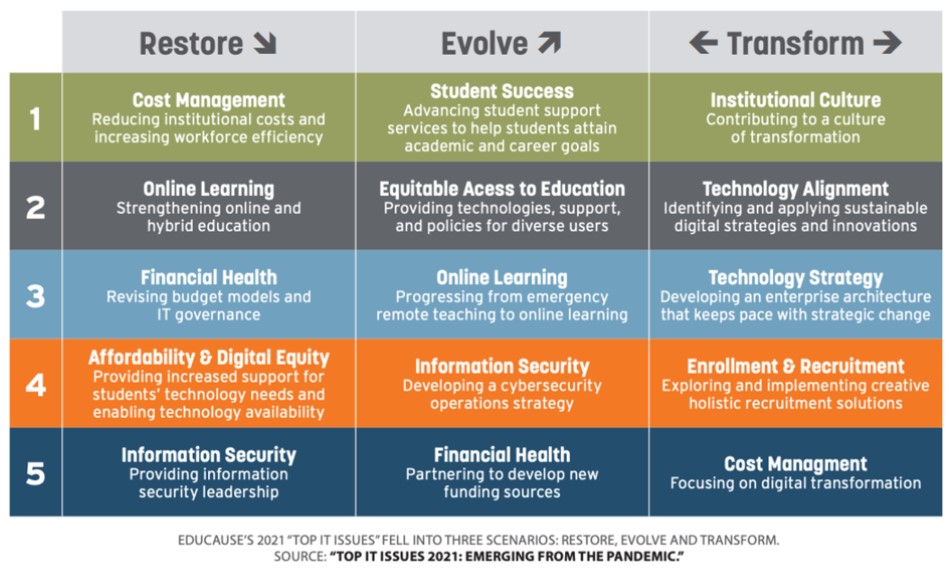Pick Your Education Path: Restoration or Transformation
Education can return to the way things have been done by restoring previous practices or it can be transformed and become something bigger and better

A recent EduCause conference included a wonderful graphic (above) that perfectly describes where we are in education today. It lays out three categories institutions fall in as they are rebooting post lockdown.
The chart is focused on IT issues but the question can be asked of all aspects of educational systems: Are we going to restore, evolve, or transform?
This is critical as we are entering the second semester of our post-lockdown year and a question that will determine your overall approach to educating students in the years to come. Consider the freshman of 2019. They have yet to have a ‘normal’ school year and they are sliding into their senior year next year. Not only have they not had traditional high school years but their college experience will be very different now than it would have been before COVID.
So, what does a school or district need to look like as we peer into our education crystal ball?
Here are a few trends coming out of COVID that may help us determine the next steps.
Blended Learning
Blended learning has been referenced as an instructional approach since the mid-2000s, however, but COVID helped districts take a deeper dive into it. When you consider the model, think of it as a continuum in which online is at one end and face-to-face is at the other. Many districts that were in the middle (referred to as “hybrid” in the continuum) during and post lockdown are seeing the benefits of the model. Research suggests that significant academic gains occur when teachers utilize blended learning methodologies [See Christensen Institute for research findings]. This approach is predicted to be widely adopted and perhaps even become the norm for teaching.
Social and Emotional Learning
Districts that are typically large and urban pay close attention to social and emotional learning models. CASEL is one of the best-known models and is widely adopted in these schools. Lockdown created uncertainty in the lives of most students around the world and their social and emotional well-being takes center stage as we begin to reorient them to schooling. Some federal funding is designated for the well-being of students and districts are taking advantage as they determine how to balance health and wellness with academic outcomes.
Tools and ideas to transform education. Sign up below.
Assessment
The disruption of assessment was probably one of the bright spots of the lockdown. Many district leaders have argued that high-stake assessments don’t accurately measure student outcomes and some states have taken the cue and designed alternative ways to measure progress. The post-lockdown era will accelerate modifications to high-stake models. Not taking away the accountability but considering the most effective ways to accurately measure student growth rather than a snapshot in time will ultimately lead to better outcomes.
We are at a pivotal point in education today. We can return to the way we’ve always done things by restoring our previous practices or we can truly transform and become something bigger and better. What path will your district take?
If any of these three trends resonate with you, let us know by Tweeting us at #TLTechLive and sharing your post-lockdown stories of success!
Dr. Ray's career includes designing technology within the Frist Center for the Visual Arts and directing technology research through Vanderbilt University School of Medicine Science Outreach programs. As a district administrator for Metropolitan Nashville Public Schools, she led the award-winning design, implementation, and evaluation of instructional technology programs, including instructional design for online and blended learning environments, redesigning physical learning environments, redefining school libraries, and establishing the first virtual high school to award the diploma. She leads K20Connect and other passion projects supporting K20 education around the world.

